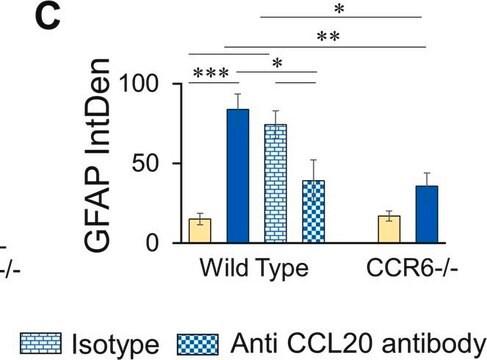Kluczowe dokumenty
C9205
Anti-Glial Fibrillary Acidic Protein (GFAP)−Cy3™ antibody, Mouse monoclonal
clone G-A-5, purified from hybridoma cell culture
Synonim(y):
Anty-ALXDRD
Wybierz wielkość
1990,00 zł
Wybierz wielkość
About This Item
1990,00 zł
Polecane produkty
pochodzenie biologiczne
mouse
białko sprzężone
CY3 conjugate
forma przeciwciała
purified immunoglobulin
rodzaj przeciwciała
primary antibodies
klon
G-A-5, monoclonal
Formularz
buffered aqueous solution
reaktywność gatunkowa
human, pig, rat
metody
direct immunofluorescence: 1:400 using alcohol-fixed, paraffin-embedded rat brain sections
izotyp
IgG1
numer dostępu UniProt
Warunki transportu
wet ice
temp. przechowywania
2-8°C
docelowa modyfikacja potranslacyjna
unmodified
informacje o genach
human ... GFAP(2670)
rat ... Gfap(24387)
Szukasz podobnych produktów? Odwiedź Przewodnik dotyczący porównywania produktów
Opis ogólny
Specyficzność
Immunogen
Zastosowanie
- immunohistochemistry[1]
- immunoblotting
- immunolabelling,
- immunocytochemistry
- immunofluorescence
Działania biochem./fizjol.
Postać fizyczna
Informacje prawne
Oświadczenie o zrzeczeniu się odpowiedzialności
Nie możesz znaleźć właściwego produktu?
Wypróbuj nasz Narzędzie selektora produktów.
produkt powiązany
przeciwciało
Kod klasy składowania
10 - Combustible liquids
Klasa zagrożenia wodnego (WGK)
nwg
Temperatura zapłonu (°F)
Not applicable
Temperatura zapłonu (°C)
Not applicable
Środki ochrony indywidualnej
Eyeshields, Gloves, multi-purpose combination respirator cartridge (US)
Wybierz jedną z najnowszych wersji:
Certyfikaty analizy (CoA)
Nie widzisz odpowiedniej wersji?
Jeśli potrzebujesz konkretnej wersji, możesz wyszukać konkretny certyfikat według numeru partii lub serii.
Masz już ten produkt?
Dokumenty związane z niedawno zakupionymi produktami zostały zamieszczone w Bibliotece dokumentów.
Klienci oglądali również te produkty
Active Filters
Nasz zespół naukowców ma doświadczenie we wszystkich obszarach badań, w tym w naukach przyrodniczych, materiałoznawstwie, syntezie chemicznej, chromatografii, analityce i wielu innych dziedzinach.
Skontaktuj się z zespołem ds. pomocy technicznej













